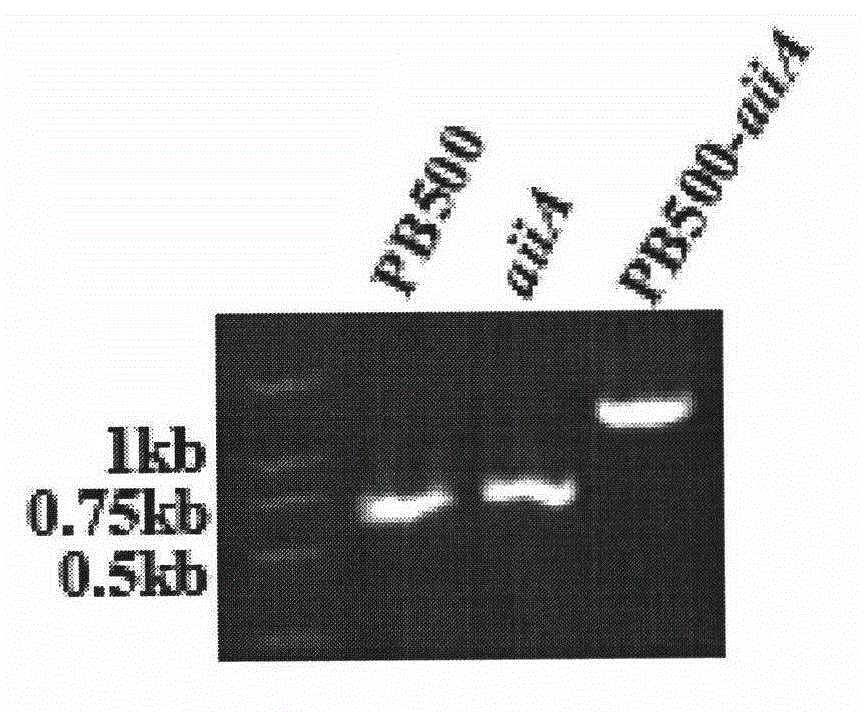Construction and application of unmarked lysobacter enzymogenes engineering strain capable of preventing plant bacteriosis
An enzyme-producing lysobacteria, plant bacteria technology, applied in the application, bacteria, plant growth regulators and other directions, can solve the problem of target gene function loss, etc., to achieve the effect of broadening the scope of biocontrol
- Summary
- Abstract
- Description
- Claims
- Application Information
AI Technical Summary
Problems solved by technology
Method used
Image
Examples
Embodiment 1
[0022] Example 1: Construction of a marker-free engineered strain of Lysobacterium enzymogenes containing PB500-aiiA
[0023] 1 Materials and methods
[0024] 1.1 Test materials
[0025] The Escherichia coli strain DH5α used in this experiment was purchased from Dalian Bao Biological Company (TaKaRa), and the SM10λpir and DH5αλpir strains were donated by Professor Zhu Jun, School of Life Sciences, Nanjing Agricultural University. Lysobacterium enzymogenes was isolated and preserved by the inventors. The vector pEXl8GM was kindly donated by Professor Zhu Jun, School of Life Science, Nanjing Agricultural University. Plasmid pME6863 was a kind gift from Prof. Molina of the Swiss Federal Institute of Technology. The culture of Escherichia coli strains uses LB medium, the culture temperature is 37°C, and the speed of liquid culture is 225 rpm / min. The lysobacterium enzymogenes was cultured using LB medium, the culture temperature was 30° C., and the rotation speed of the liquid...
Embodiment 2
[0038] Example 2: The biocontrol application of the unmarked engineered strain of Lysobacterium lysobacterium containing PB500-aiiA to bacterial soft rot
[0039] 1 Materials and methods
[0040] 1.1 Test material
[0041] The Agrobacterium tumefaciens used in this experiment was kindly donated by Professor Zhu Jun, School of Life Science, Nanjing Agricultural University. Lysobacterium enzymogenes and soft rot pathogen of Chinese cabbage were isolated and preserved by the inventor. The vector pME6863 was kindly provided by Prof. Molina of Swiss Federal Institute of Technology. LB medium was used for bacterial culture, the culture temperature was 30° C., and the rotation speed of liquid culture was 225 rpm / min. Antibiotics gentamicin (Gm), streptomycin (Sm), spectinomycin (Spe), tetracycline (Tc), 5-bromo-4-chloro-3-indole-β-D-galactoside (X -gal), SDS, NaCO3 and other chemical reagents were purchased from Nanjing Zhuyan Biological Company.
[0042] 1.2 Extraction and dete...
PUM
 Login to View More
Login to View More Abstract
Description
Claims
Application Information
 Login to View More
Login to View More - R&D
- Intellectual Property
- Life Sciences
- Materials
- Tech Scout
- Unparalleled Data Quality
- Higher Quality Content
- 60% Fewer Hallucinations
Browse by: Latest US Patents, China's latest patents, Technical Efficacy Thesaurus, Application Domain, Technology Topic, Popular Technical Reports.
© 2025 PatSnap. All rights reserved.Legal|Privacy policy|Modern Slavery Act Transparency Statement|Sitemap|About US| Contact US: help@patsnap.com



